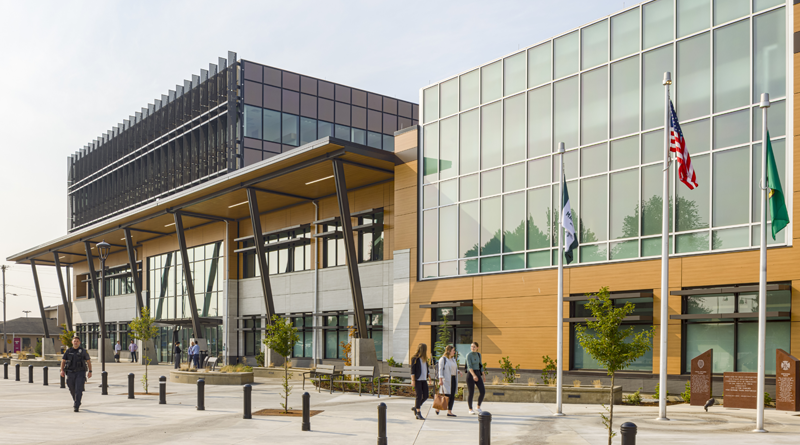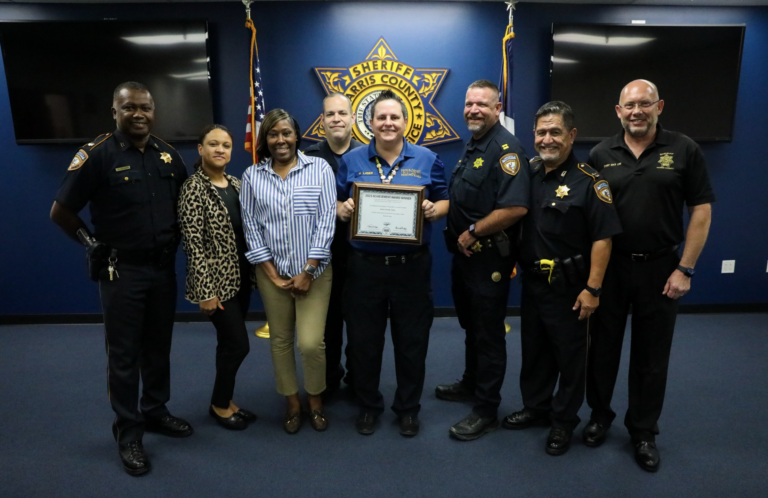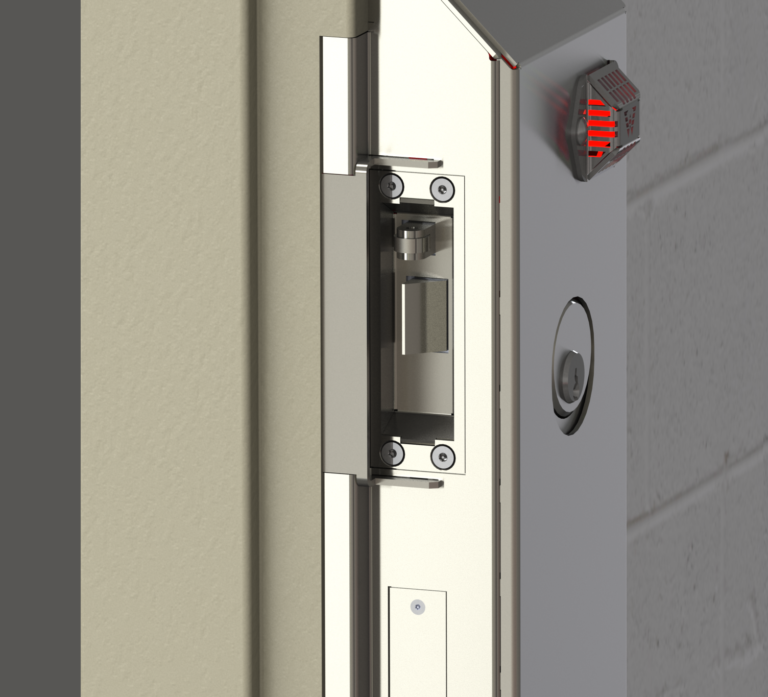New Marysville, WA Venue Shines as Dynamic Civic Campus

By Lori Coppenrath
Located 35 miles north of Seattle, the City of Marysville is known for its rich farmland, good schools, and family-friendly parks. But up until 2023, its city government was also known for being scattered across the city without one place to call home. This reality not only gave rise to inefficiencies in operation but also inconveniences for citizens needing to access multiple departments of the city.
As part of a larger downtown redevelopment plan, the city hired DLR Group, in partnership with BNH Architects, to help bring together and unite city services to create an iconic one-stop city services campus. The design of the new Marysville Civic Campus welcomes residents and visitors, sets a new architectural standard for the city, and engages with an adjacent city park.
FINDING COMMON GROUND
In order to find common ground on developing a one-stop city service campus, DLR Group started the planning process meeting with stakeholders from every department in community meetings, seeking out the needs and preferences not only in operations, but also in the form and aesthetics of the facilities. Based on these conversations, it was initially determined that the city needed space that would require a six-story building on the selected site which would require a $72 million budget.
However, the city’s final budget peaked at a $53.8 million investment. The team was able to meet the budget restriction by reducing scope of work and shifting some spaces to core and shell for future expansion, eliminating a roof-deck, and designing the jail to accommodate future additions if needed.
The result is a new 101,200 SF civic campus that includes city hall, courts, jail, police, permit counter, and a one-stop city services shop. Shared amenities include conference and meeting rooms, print and workrooms, as well as break and gathering spaces and third spaces. Shared spaces reduce staff duplication and increases efficiency, creating a culture of openness, collaboration, and cross pollination of ideas across the different departments.
Third spaces are team-focused spaces that contrast with individual-focused personal offices or workstations. Decreasing the size of individual workspaces allowed for a wider variety of meeting, support, and amenity spaces within the same square footage. These changes provide additional choice and flexibility to accommodate the work styles of a continually modernizing workforce, leading to increased health and happiness of city employees and aids in employee retention in a competitive market.
THE PUBLIC EXPERIENCE
A member of the public does need to know how city departments are organized in order to access services. Disparate departments such as police and courts are folded into the traditional city hall services to portray a unified front for the city. And a single entry point into the building directly across from Comeford Park prevents confusion in terms of wayfinding. The three primary functions – City Hall, Municipal Courts, and Police Station are arrayed around the central lobby in order to further clarify where to go when inside the building.
The question for the city and the team was ‘how do we make it easier for the public to navigate?’ And the response was not just in a specific wayfinding system, although that was an important piece, but rather the city created a one-stop information counter upon entry where individuals can ask questions and be directed to the appropriate areas. The project was centered around the customer experience which became much easier for citizens to navigate through the services where they needed to interact.
Interaction with city staff and commissioners during planning and design resulted in a design aesthetic that reflects Marysville’s vision for the future. Warm wood tones and expansive windows welcome the public and convey transparency of government. The campus features a main boulevard and public plaza that will eventually connect several blocks to the waterfront. The City of Marysville envisions this boulevard as a pedestrian-friendly corridor that hosts community activities and events.
SAFE AND SECURE
One of the key design goals beyond creating efficiencies and synergies between all city services was for this project to be a safe and secure campus for employees as well as the public. At the same time, it needed to create an inviting, welcoming sense of civil trust and appreciation for the public. In creating secured zones throughout the facility, city hall and general city services were located on the first two floors which are more accessible to the public. The top two floors have added security screening for the city attorneys, finance, and mayor’s office. And the public counter for the police station is secured behind protective glass windows.
Two staff entries for the police/jail and one for city hall use badge-control systems to enter secure corridors and elevators. A secured vehicular sallyport connects jail, police, and courts. Once an individual is brought in through the secured sallyport, they can be brought through intake, to a vestibule, and then taken by secured elevator directly to a holding area between the two courtrooms, which maintains a secure perimeter for the other areas of the campus.
Although the city jail is part of the campus, access into that part of the facility for the public is through a separate entryway to maintain a secure public lobby. The police and city jail have always needed to be connected, and now they are within steps of each other. But once inside the city campus, it’s easy to forget that a jail is 100 feet away. The goal was to provide all the city services, including the jail, without making it look like a jail.
The public safety building includes two courtrooms on the second floor, as well as a clerk’s area with public service window, a jury assembly room that can also be used for training, and jury deliberation areas. On the ground-floor, the police station supports 55 commissioned officers serving one of the nation’s fastest growing communities. The facility includes records, administration, investigations, patrol, armory, evidence, and training spaces. Adjacent to the police facility, a full-service, 84-bed jail, expandable to 160 beds, includes intake, release, medical, programs, food service, laundry, administration, visiting, and housing.
BETTER OUTCOMES, BETTER COMMUNITY
The focus of designing a campus that would improve community and individual lives is seen throughout the campus. Those interacting with the court system will experience a less stressful process and an environment that is flooded with daylight. For the court specifically, stress-reducing features found in warm wood finishes, and expansive views, give people release from the stress of the moment. Also significantly improved staff space to decompress from secondary trauma that is common in police and court settings are assisting staff in dealing with the pressures of the work environment.
The connection to the city’s historic Comeford Park via the outdoor plaza, creates an important community gathering spot for future events and city festivals.
“We have moved into the Civic Center, and it is beautiful,” said Gloria Hirashima, Marysville Chief Administrative Officer. “Universally, the Mayor, Council and staff are pleased with the space and the function.”
Betterment of the community and individual experience is realized in this integrated civic campus that serves both the public and the staff in thoughtful ways.
Lori Coppenrath serves as a DLR Group Principal and Justice+Civic Planning Leader.
Editor’s Note: This article originally appeared as the Facility of the Month feature in the May/June 2023 issue of Correctional News.






